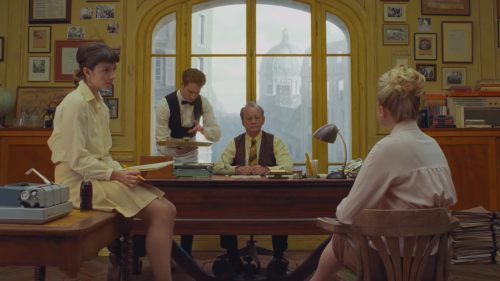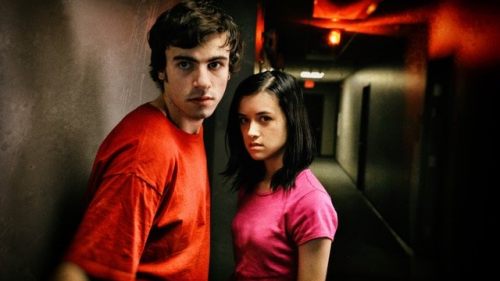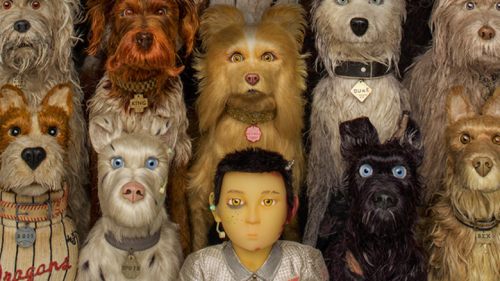SXSW Review: ISLE OF DOGS Is Wes Anderson’s Puppy Kaiju Picture
Before Isle of Dogs, the notion of Wes Anderson helming a Godzilla picture was unfathomable. Now, it’s all this writer can think about. Anderson’s stop motion animated adventure – set in the near future fictional Japanese metropolis of Megasaki – is a visual feast, steeped in the country’s cinema and showcasing obvious influences that range from the epics of Akira Kurosawa (particularly High and Low), to the kaiju stomping diversions Toho’s been churning out for the last six decades. In short, Isle of Dogs isn’t an act of appropriation, but rather one of pure celebration.
Co-written by Kunichi Nomura – along with Anderson and his usual array of conspirators (both Roman Coppola and Jason Schwartzman own a “story by” credit) – the end result could’ve easily come across as shameless cultural tourism. Yet there’s an immersive element to the numerous allusions to Japanese art that couples well with Isle of Dogs’ refusal to give in to Western linguistics. As stated in a title card upfront, much of the Japanese dialogue – voiced by actual Japanese actors (believe it or not) – goes untranslated, placing us inside this invented locale but never letting us forget that this is indeed a story that belongs to hyper-specific ethnic touchstones. When amalgamated with Anderson’s own signature “doll house” style, Isle of Dogs becomes a true gift to cinephiles, exploding with color and texture while barely masking a political statement regarding the corruption of systems through dubiously conceived policy and sinister mass propaganda.
Isle of Dogs’ central conflict is one that stretches back centuries, as the Kobayashi clan once waged war on a pack of stray dogs, their allegiance to the country’s cats fueling an aggression they ultimately lost. Cut to some time in the 2030s, and Mayor Kobayashi (looking like Toshirô Mifune and voiced by Nomura) – a six term incumbent on the eve of re-election – must address widespread outbreaks of “dog flu” and “snout fever” that are threatening to mutate and infect the human population. While his Science Party opponents claim to be on the brink of discovering an antidote for the epidemics, Kobayashi instead calls an emergency vote to quarantine all the city’s dogs on Trash Island (which is exactly what it sounds like, complete with an abandoned amusement park), and outlaw any canine within the limits of Megasaki. As an act of “self-sacrifice”, Kobayashi offers up Spots (Liev Schreiber) – the guardian pooch of his orphaned nephew Atari (Koyu Rankin) – to show potential voters just how committed he is to this drastic measure.
Cut to six months later and Trash Island is now essentially the puppy version of All Monsters Attack’s Monster Island, where packs of wild pups roam free amongst the mountains of garbage, fighting one another for scraps (their barks translated so we know what the hell they’re saying to one another, because no human speaks “woof woof”, after all). This new family is comprised of Chief (Bryan Cranston) – a mangy stray who often slips into a noirish Bogie cadence when addressing his own potential Bacall, Nutmeg (Scarlett Johansson) – and a gaggle of formerly domesticated beasts (who look down on this tough dog’s Nagasaki homelessness). There’s the rather verbose Rex (Edward Norton), the former baseball bar mascot Boss (Bill Murray), gossip monger Duke (Jeff Goldblum), and meek, cautious King (Bob Balaban). Together, Chief tells them they’re a pack of “indestructible alpha dogs”, but we definitely recognize them as another familiar troupe of Anderson eccentrics, all looking to define themselves in this crazy, messed up universe.
Along comes Atari, flying a tiny hijacked biplane in search of his forwent pooch, crash landing on Trash Island and becoming the fascination of these talking doggos. Their quixotic quest leads them across the entirety of the isle, where Atari (being the twelve-year-old boy that he is) stops to slide down the theme park peaks and marvel at an underground structure comprised of kaleidoscopic sake bottles. During this sojourn, Anderson pulls out nearly every visual trick from his rather deep bag, making us feel the fabric of this fantasy, packing every single frame with his usual knack for wonderous detail. Fantastic Mr. Fox cinematographer Tristan Oliver and Grand Budapest Hotel production designer Adam Stockhausen (along with animation architect Paul Harrod) are working in sync to bring this microcosmic universe to life, letting the distinct surface of it all wash over us in a euphoric haze of fanciful delight, without ever succumbing to the Japanese cutesiness of kawaii.
Perhaps most fascinating is the fact that what’s happening on the mainland may actually be more engaging than the Trash Island hijinks. Exchange student Tracy Walker (Greta Gerwig) leads a Pro-Dog protest movement, while seeking out Professor Watanabe (Akira Ito) and his assistant (Yoko Ono) to confirm that they’ve indeed cemented the particulars of “dog flu” and “snout fever” cures. This ostensible B-Plot contains the real thematic meat of Isle of Dogs, as Anderson is slyly weaving in threads regarding political corruption, the suppression of information, and how those clampdowns lead to state-controlled propaganda broadcasts. There’s even a full-blown assassination via poisoned sushi, just for good measure.
In fact, to label Isle of Dogs a “political picture” doesn’t seem too far out of line. For all the quirky laughs and overly expressive dog eyes – the designers/animators really outdo themselves in getting these stop motion canines to show emotion – there are serious messages being relayed in these 100 minutes. While our real world continues to crumble around us, that strife is mirrored even in Anderson’s most fantastical storytelling, as Isle of Dogs is hitting on the same societal barbarism that M. Gustave (Ralph Fiennes) was constantly complaining about in The Grand Budapest Hotel. Scoring it all is a procession of Japanese war drums and playful orchestration provided by Alexandre Desplat, who seems to perfectly understand this delicate balance between escapism and awareness. Meanwhile, The West Coast Pop Art Experimental Band’s “I Won’t Hurt You” acts as a sort of Greek Chorus during Atari’s journey with the dogs, crooning a comforting mantra for these wandering animals to follow.
However, the main takeaway from Isle of Dogs is what a pure fête of Japanese art and culture Anderson has constructed on a series of tiny stages (which were built and filmed in both the UK and Berlin). Everyone from Seijun Suzuki to MechaGodzilla gets a gold star placement from the Tenenbaums auteur – wait until you see the robot dogs built to combat their flesh and blood counterparts – all while he retains the thumbprint his most fervent admirers will defend until their deaths. Though some of the usual Anderson daddy issues remain (as they probably always will), Isle of Dogs joins both Moonrise Kingdom and The Grand Budapest Hotel as another mature work from the writer/director, who continues to grow and flex his creative muscles in new and exciting ways. All in all, Isle of Dogs is a stunning achievement, growing upon the tremendous experiment of The Fantastic Mr. Fox to deliver one of Anderson’s most handsomely realized visions yet.



